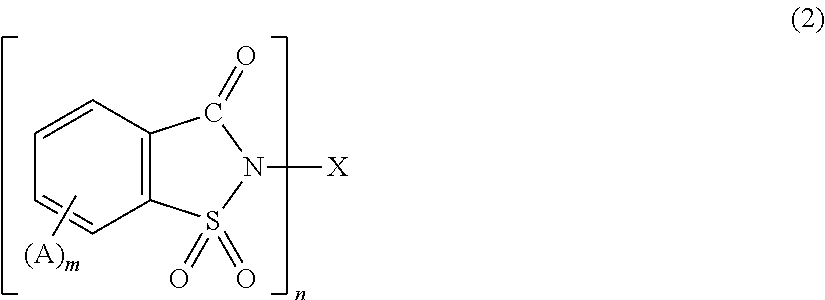Polyester resin composition, polyester fiber, polyester resin molded article, and process for production of nucleating agent for polyester resin
a technology of polyester resin and nucleating agent, which is applied in the direction of thin material processing, transportation and packaging, etc., can solve the problems of difficult to achieve an improvement in the processing cycle, limited temperature at which such molded articles can be used, and limited applications. , to achieve the effect of excellent creep characteristics, low thermal contraction rate and small particle siz
- Summary
- Abstract
- Description
- Claims
- Application Information
AI Technical Summary
Benefits of technology
Problems solved by technology
Method used
Image
Examples
examples 1-1 to 1-6
and Comparative Examples 1-1 to 1-3
[0265]The present invention will now be described in detail by way of specific production examples, examples and comparative examples; however, the present invention is not restricted by these examples and the like. Further, the average particle size and water content of sodium sulfonate metal salt were determined by the following methods.
(Average Particle Size)
[0266]The average particle size was determined using a laser diffraction-scattering-type particle size analyzer (Microtrac MT3000II; manufactured by Nikkiso Co., Ltd.) in accordance with a laser diffraction-scattering method (Microtrac method). The average particle size was defined as the value obtained when, in the histogram of particle size distribution obtained by measuring the particle size distribution (volume distribution) under a dry condition, the particle sizes were cumulatively added from the smallest ones and the integrated value became 50%.
[0267]The percent water c...
production example 1
[0268]To 100 parts by mass of a polyethylene terephthalate resin (TR-8550 manufactured by Teijin Chemicals Ltd.), 0.3 parts by mass of a sulfonamide compound metal salt (1,2-benzisothiazol-3(2H)-one-1,1-dioxide sodium salt; average particle size: 4.4 μm; water content: 0.1%) and the respective antioxidant shown in Table 1 were added and mixed well. The resulting mixture was granulated using a biaxial extruder (machine: TEX28V manufactured by The Japan Steel Works, Ltd.; cylinder temperature: 270° C.; screw speed: 200 rpm) to obtain a pellet. The yellowness of the thus obtained pellet was measured under the following conditions.
(Yellowness)
[0269]For each of the pellets obtained in the above-described Production Example 1, a 60 mm×60 mm×1 mm sheet was molded using an injection molding machine EC100 manufactured by Toshiba Corporation (molding conditions: injection temperature of 270° C., injection time of 20 seconds, die temperature of 25° C. and die cooling time of 30 seconds) and th...
reference example 1
[0270]A pellet was obtained in the same manner as in the above-described Production Example 1, except that the 1,2-benzisothiazol-3(2H)-one-1,1-dioxide sodium salt and antioxidant were not blended. The yellowness of the thus obtained pellet was determined. The result thereof is shown in Table 1.
TABLE 1Sulfonamidecompound metal saltAntioxidantAddedAddedEvaluationamountCom-amountYellownessCompound[phr]pound[phr](YI)Example 1-1N-10.3P-10.14.8Example 1-2N-10.3P-20.13.3Example 1-3N-10.3P-30.13.3Example 1-4N-10.3P-3 0.033.5Example 1-5N-10.3P-30.33.3Example 1-6N-10.3P-40.15.0ComparativeN-10.3——6.0Example 1-1ComparativeN-10.3A-10.16.2Example 1-2ComparativeN-10.3A-20.15.2Example 1-3Reference————3.0Example 1N-1: 1,2-benzisothiazol-3(2H)-one-1,1-dioxide sodium saltP-1: 2,2-methylenebis(4,6-di-t-butylphenyl)octyl phosphiteP-2: bis(2,4-di-t-butylphenyl)pentaerythritol diphosphiteP-3: bis(2,6-di-t-butyl-4-ethylphenyl)pentaerythritol diphosphiteP-4: tris(2,4-di-t-butylphenyl)phosphiteA-1: tetrakis...
PUM
| Property | Measurement | Unit |
|---|---|---|
| temperature | aaaaa | aaaaa |
| temperature | aaaaa | aaaaa |
| volume average particle size | aaaaa | aaaaa |
Abstract
Description
Claims
Application Information
 Login to View More
Login to View More - R&D
- Intellectual Property
- Life Sciences
- Materials
- Tech Scout
- Unparalleled Data Quality
- Higher Quality Content
- 60% Fewer Hallucinations
Browse by: Latest US Patents, China's latest patents, Technical Efficacy Thesaurus, Application Domain, Technology Topic, Popular Technical Reports.
© 2025 PatSnap. All rights reserved.Legal|Privacy policy|Modern Slavery Act Transparency Statement|Sitemap|About US| Contact US: help@patsnap.com



